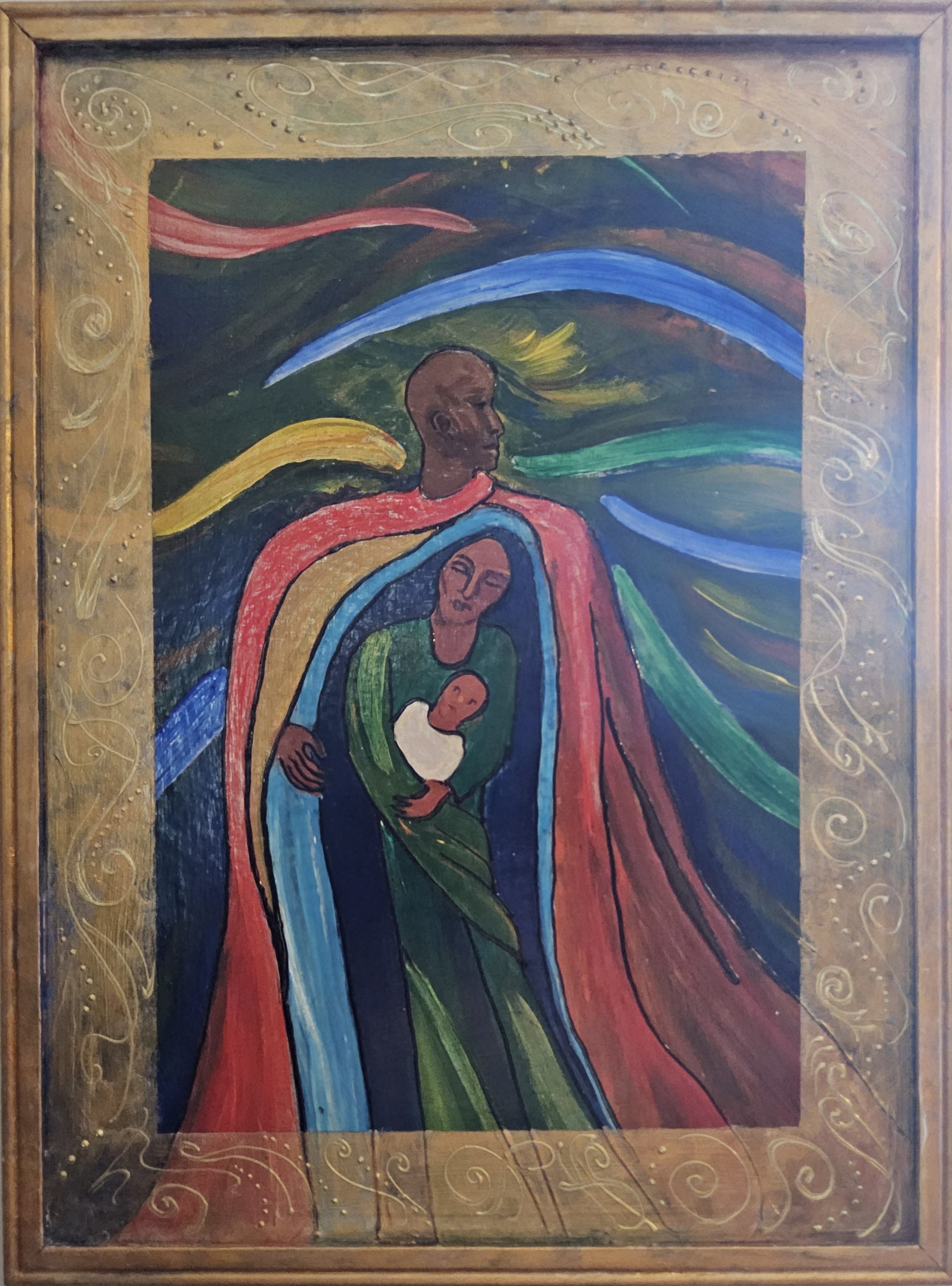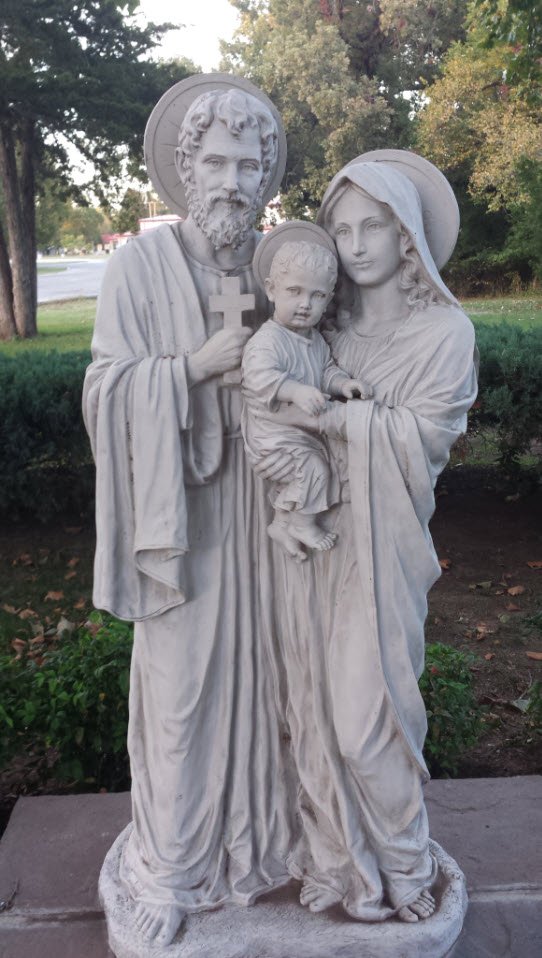Joseph: Man of Wisdom (Sophos)
This week we are pleased to share a guest writing from Robert Powell. Robert is one of our Sunday Gathering Bell Ringers and brings a rich background of spiritual, philosophical, and coaching study and practice to his consideration of masculinity. A Roman Catholic ex-seminarian, Robert holds a Ph.D. in American metaphysics and did his dissertation on the writings of Alfred North Whitehead which led him to be an early adapter of Ken Wilber’s Integral Theory and then to Paul Smith’s Integral Christianity. For the last 31 years, he has been active in multiple roles in the ManKind Project.
“Flight into Egypt” – painting by Wayne Toy Him
Celebrating The Holy Family
Christmas has come and with it, the ever-renewing birth of Christ Consciousness. In the Adventing series, we contemplated the role of Christ Sophia, the divine and human Wisdom in its feminine mode.
Yet, as the writings pointed out, Christ Consciousness is neither feminine nor masculine alone, but a non-binary, non-dual incarnated unity of Spirit and Creation. There are “feminine” and “masculine” tones and overtones that dance in the endless swirl of emergent evolution that we experience as our lives.
If Mary is, in her “Fiat” – “Let it be done unto me” – the symbol of Sophia, the feminine in Christ Consciousness in the Nativity stories, then Joseph may be viewed as the symbol of Sophos, the masculine in Christ Consciousness.
In Jesus, whom Richard Rohr likes to describe as a feminine soul in a masculine body, the fullness of Christ Consciousness is revealed and modeled for all creation for all time.
And, together, Jesus, Mary, and Joseph form the Holy Family as the model for healthy, loving, and supportive relationships among people, as well as an analog for individual growth into full Christ Consciousness.
The Masculine-Feminine Typology
It is true that “feminine” and “masculine” appear to relate to gender and physical sexuality. But, in this context, they are terms in a particular typology that actually refer to a set of characteristics used to describe individuals. Each characteristic is itself a polarity, that is, a range or spectrum between two positive, but contrasted, values. For instance, “nurturing” and “challenging” can be viewed as the end points of a parenting style spectrum where each person, regardless of gender identity, will find their comfort zone and, with time, may be able to access any point as needed.
Over time, one end of each spectrum became associated with the traditional role of males and the other end with the traditional role of females. To concretize and privilege this duality, cultures assigned the adjectives “masculine” and “feminine” to the sets and placed great values on men and women conforming to their “type.” In the patriarchical cultures, the masculine set also became privileged over the feminine set.
In reality, no individual is fully “masculine” nor fully “feminine.” Each is a unique blend of characteristics that fall somewhere on each of the spectrums in the typology. Today’s emerging culture is deconstructing the imposition of binary categories upon individuals and looking to integrate a more holistic view of these characteristics.
Reclaiming the Sacred Masculine
In the process of acknowledging and celebrating the historically denigrated Feminine, there has been a tendency, in some circles, to demonize the masculine typology and blame it for all the ills of the world. Sometimes, this construct is labeled “Toxic Masculinity.”
Yet, if Christ Consciousness is embodied in everything and everybody, there must be a Sacred Masculine as well as a Sacred Feminine. A Christ Sophos to complement Christ Sophia. And only in their sacred marriage can a person give birth to the Christ within.
My own 30+ years of integrative work within the ManKind Project leads me to believe we can identify and nurture the Sacred Masculine. The MKP Mission is “to create a world where men act on their individual and collective responsibility for the future of humanity by initiating and supporting men on a path of emotional maturity, spiritual awareness, and deepening community.”
Coming from this perspective, the character of Joseph described in the Gospels embodies the Sacred Masculine of Christ Sophos. Through the lens of hermeneutics, we can see the literal, moral, allegorical, and anagogical ways in which Joseph epitomizes this Sacred Masculine in each of us.
Joseph is Presented as the Just Man
Joseph is described as the father of Jesus in all four Gospels, but Mark and John say nothing more. Matthew, however, describes him as “being a just man,” and there is much to unpack in that word “just.” First of all, it means that he was faithful to the Law and followed its precepts. It also means that he was a man of integrity and sought to live in right relationship with others. All this before he learns how Mary came to be pregnant. His response to the situation is to be compassionate toward her and end their relationship quietly.
When he learns from the angel of the Lord in a dream that Mary is pregnant of holy Spirit, he remains committed to Mary and her Child. Richard Rohr points out,
“These were two laypeople who totally trusted their inner experience of God and followed it to Bethlehem and beyond. There is no mention in the Gospels of the two checking out their inner experiences with the high priests, the synagogue, or even their Jewish Scriptures. Mary and Joseph walked in courage and absolute faith that their experience was true, with no one except God to reassure them they were right. Their only safety net was God’s love and mercy, a safety net they must have tried out many times, or else they never would have been able to fall into it so gracefully.”
These characteristics – faith, integrity, compassion, and commitment – mark Joseph as a righteous man and are signs of the Christ Sophos being already alive in him.
Joseph is an Old Soul in a Young Man
There is a tradition that portrays Joseph as an older man. This, perhaps, derived from a pious desire to explain why he and Mary didn’t have a normal married life. There is nothing in the Gospels that justifies this assumption, but there is an aspect of the Sacred Masculine that may, oddly enough, offer another reason for thinking Joseph older than he was.
The Sacred Masculine seems to require a greater maturity to manifest in a person, while the Sacred Feminine can appear at earlier periods in a person’s life. For instance, the Latin equivalent of the Greek Sophos is “Senex” or “old wise man.” It could be that it takes more life experience to prepare us to accept Christ Sophos than to welcome Christ Sophia.
Joseph appears to have been well on his way to embodying the Sacred Masculine and Mary’s situation and his inner knowing matured him.
Joseph is a Moral Protector, Provider, and Teacher
In the stories of the shepherds, the magi, the presentation in the Temple, the flight into Egypt and return to Nazareth, and finding Jesus among the doctors of the Law, Matthew and Luke show us the just man in action. Note that Joseph has no spoken lines in any of the gospels, just his presence, his attentiveness to God’s directives, and his loving care of his wife and child. Where Christ Sophia leads Mary to “store up all these things in her heart,” Christ Sophos inspires Joseph to take action to keep them safe and to hold space for Jesus to grow in wisdom and grace during the hidden years.
The Sacred Masculine looks to be, and to be held, accountable for how Christ Sophos inspires us to show up in the world. At the traditional stage of cultural evolution that held sway in first-century Judea, the accepted way is to see this as the man’s role and Joseph fulfills it without complaint. As we’ll see, at the integral stages of culture, these gender-based role assignments fade away. Still, Joseph is presented as a model of the Sacred Masculine in his outward-looking stance of protector, provider, and teacher.
Joseph is the last in the line of Patriarchs
Both Mark and Luke present the lineage of Joseph as an allegorical type of the patriarchs of Jewish history (Abraham, Isaac, Jacob, Joseph, David) to point to Jesus as the culmination of the line of descent issuing in the fulfillment of God’s promise to Abraham to be the ancestor of a great people, now spreading beyond the tribes of Israel to encompass the entire world.
When Joseph presents the baby Jesus for circumcision and then for purification and consecration in the Temple, he is claiming him as his firstborn son under the law. In a culture that highly valued the paternal line, this was how Jesus could prove his descent from King David.
In the prophecy of Simeon, we see Christ Sophos declaring Jesus to be the beginning of a new covenant. In the prophecy of Anna, we see Christ Sophia proclaiming the good news to all.
In this way, the nativity stories point toward the coming age of Christ Consciousness.
The Holy Family is a model of Spiritual Evolution
Much of the language used so far cannot help seeming to reinforce traditional tropes of male and female domains. Even though we seek to remember that “masculine” and “feminine” refer to modes of feeling and behaving and not to the gender of people, thousands of years of usage can weigh heavily. Even the modern stage, for all its demythologizing and scientific theorizing, has failed to rewire our understanding of the polarity that underlies the masculine-feminine typology.
Nor has the postmodern stage of the past sixty years disabused us completely of the dualistic interpretation that pits the masculine against the feminine. Rather, it has, in its efforts to undo the damage of the past, in many cases simply reversed the bias to privilege the feminine over the masculine.
Only when we truly understand that the typology is a polarity and both ends are positive and necessary responses to experience can we begin to re-integrate the masculine and feminine and honor both types in ourselves and in the world.
Looking at the Holy Family as an anagoge may help us to see how we can accomplish this task. Like the divine dance of the trinity, the Holy Family points to how a fully realized Christ Consciousness becomes incarnate in each of us and in the community through the integration of the Sacred Feminine and the Sacred Masculine and produces a unique incarnation of the divine.
As we’ve learned over the last four Sundays, the Sacred Feminine embodied in Christ Sophia must be acknowledged, honored, and allowed her rightful place within each of us. Likewise, the Sacred Masculine embodied in Christ Sophos must be freed from the power dynamics of earlier stages of evolution so that his role may be recognized and empowered within us as well.
The attributes of Joseph the just man and of Mary the woman full of grace join together to produce Jesus the child who is a light unto the world. That is our destiny achieved only when we know ourselves well enough to honor the God-within and allow ourselves to transform.









